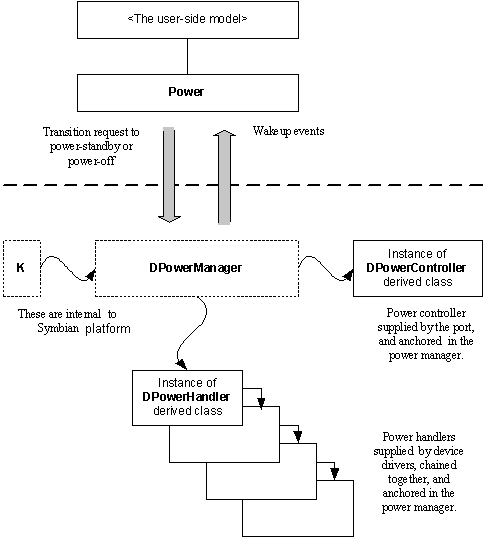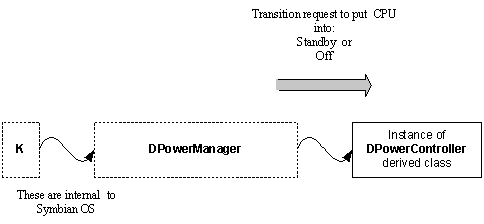Power Management
The kernel provides a framework for managing power within the system, and the management of the transition between power states.
The kernel-side framework manages the transition between power states on the device. A base port can implement a kernel extension to interface to the power management hardware that is provided on the phone. The framework also provides an interface for device drivers to use the power
The user-side interface to the framework is provided by the Power class in the User Library. This allows applications can be notified about, and can react to, changes in power state, and indeed can initiate changes to power state. The Domain Manager component provides a way to manage the power needs and dependencies of applications.
In Symbian platform, an initial port of the system does not require the existence of a power model. In this sense it is optional, and its absence will result in default behaviour provided by Symbian platform. However, this is not likely to result in optimal power usage, so the development of a power model based on the framework provided by Symbian platform will be required for commercial devices.
The interfaces for power management on the kernel-side are shown in the following diagram:
The power manager manages the transition between power states.
The power controller is a kernel extension that manages the device-specific power management hardware such as an on-chip power management controller, oscillators etc. The power controller kernel extension is provided in the base port.
Power handlers are device drivers that interface to the power manager.
The following sections describes these concepts in more detail.
Power manager
The power manager manages the transition between power states. It co-ordinates the change in the power state of peripherals and the CPU (hardware), and provides the necessary interactions with the device (peripheral) drivers and the power controller (software). It also manages interactions with the user-side model.
The power manager is an instance of the DPowerManager class, an object that is private to Symbian platform. This object is created when the system is initialised, but is not installed as the power manager until the power controller has been created and registered. Until the DPowerManager object is installed as the system's power manager, Symbian platform manages power using built-in default behaviour.
The user-side uses the Power class, a set of static functions, as an interface to the power manager. This allows the user side to request a transition to the Standby or Off state, and to request notification of wake-up events, i.e. events that will cause a transition back to the Active state.
The power manager object is the anchor point for the power controller object and the power handler objects.
Power controller
The power controller manages the device-specific power management hardware such as an on-chip power management controller, oscillators etc.
The power controller is an instance of a DPowerController class. This is an abstract class that requires an implementation . A concrete implementation supports power management hardware that is Variant specific. Typically, the Variant creates a power controller object when the Variant is initialised, and then registers it with the power manager through a call to DPowerController::Register(). Registration puts a pointer to the DPowerController object into the Symbian platform internal DPowerManager object.
The power controller is responsible for tracking wake-up events, notifying the power manager of such events through a call to DPowerController::WakeUpEvent().
Power handlers
Device drivers interface to the power manager through the DPowerHandler class. This is an abstract class that requires a concrete implementation by device (peripheral) drivers.
How a DPowerHandler object fits into a driver's own object model is a matter of individual device driver design. However, after construction of this object, the driver is expected to register it with the power manager by calling DPowerHandler::Add(), after which it will receive notification of changes to the power state.
The power manager calls DPowerHandler::PowerDown() when it requests a power state transition to either the Off or the Standby state. The power manager calls DPowerHandler::PowerUp() when it requests a power state transition to the Active state. The driver must respond to a power transition notification after it has dealt with it by calling DPowerHandler::PowerUpDone() or DPowerHandler::PowerDownDone() as appropriate.
Shared power sources
See the Power Resource Manager documentation for more information.
The set of power sources on a device, how they are connected to peripherals, and their power states are totally dependent on the specific device. This means that Symbian platform cannot provide a comprehensive API for handling such sources.
However, Symbian platform does provide an interface, MPowerInput, through which drivers register their use of a power source and their release of that power source. Symbian platform makes the following recommendations:
Each (shared) power source is represented by a separate object.
The class, or class hierarchy, that represents the power source should implement the MPowerInput interface so that device (peripheral) drivers can register their use or their release of that power source.
Define a custom interface with the power controller. It is likely that the Variant will be responsible for providing the implementation for the power inputs, and for providing this custom interface.
Drivers that need power from a specific power source call MPowerInput::Use() on the object that represents that power source. To release dependence on that power source, the driver calls MPowerInput::Release().
To represent a shared power source, a suggested implementation of MPowerInput might be to associate a counting value with the power source object. A call to Use() would increment the counter, while a call to Release() would decrement it. On construction of the object, the initial value might be 0, indicating that no peripherals require power from this source. A value of 1 or higher would indicate that one or more peripherals require power from this source. The implementation would, therefore, cause this power source to be kept on while at least one peripheral needs it; the power source would only be switched off when no peripherals need power from it.
Copyright ©2010 Nokia Corporation and/or its subsidiary(-ies).
All rights
reserved. Unless otherwise stated, these materials are provided under the terms of the Eclipse Public License
v1.0.


